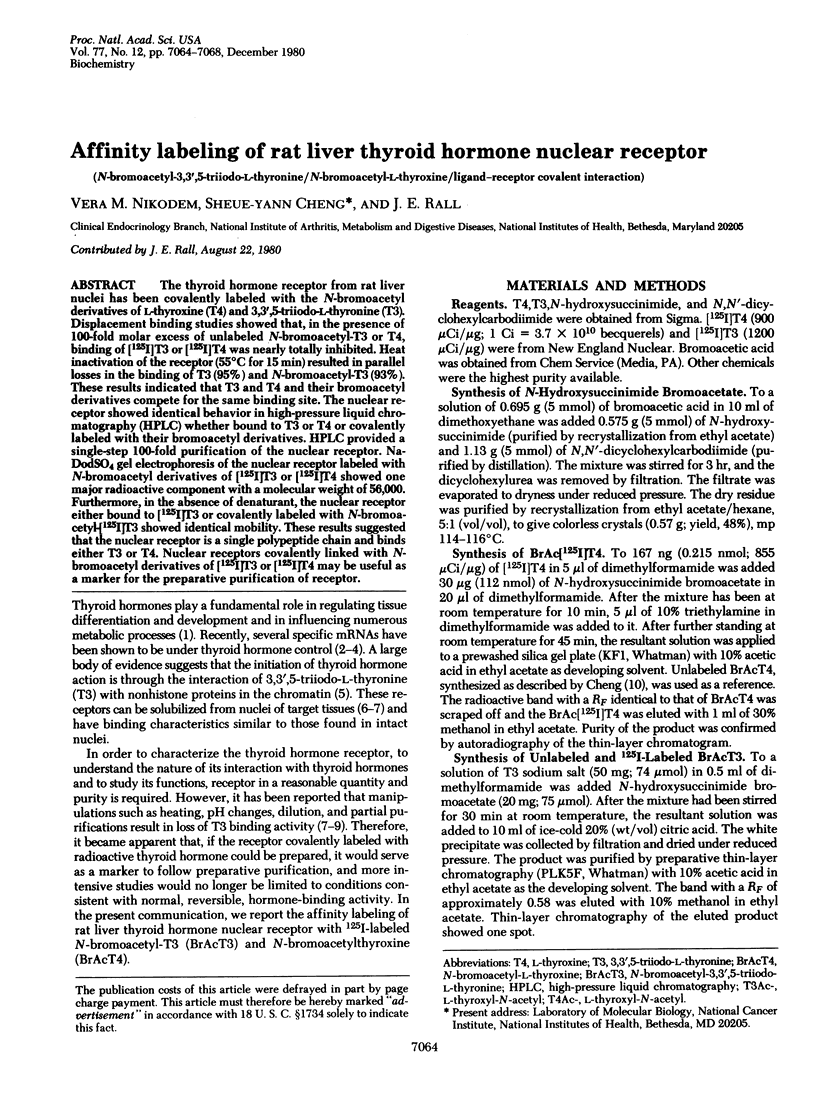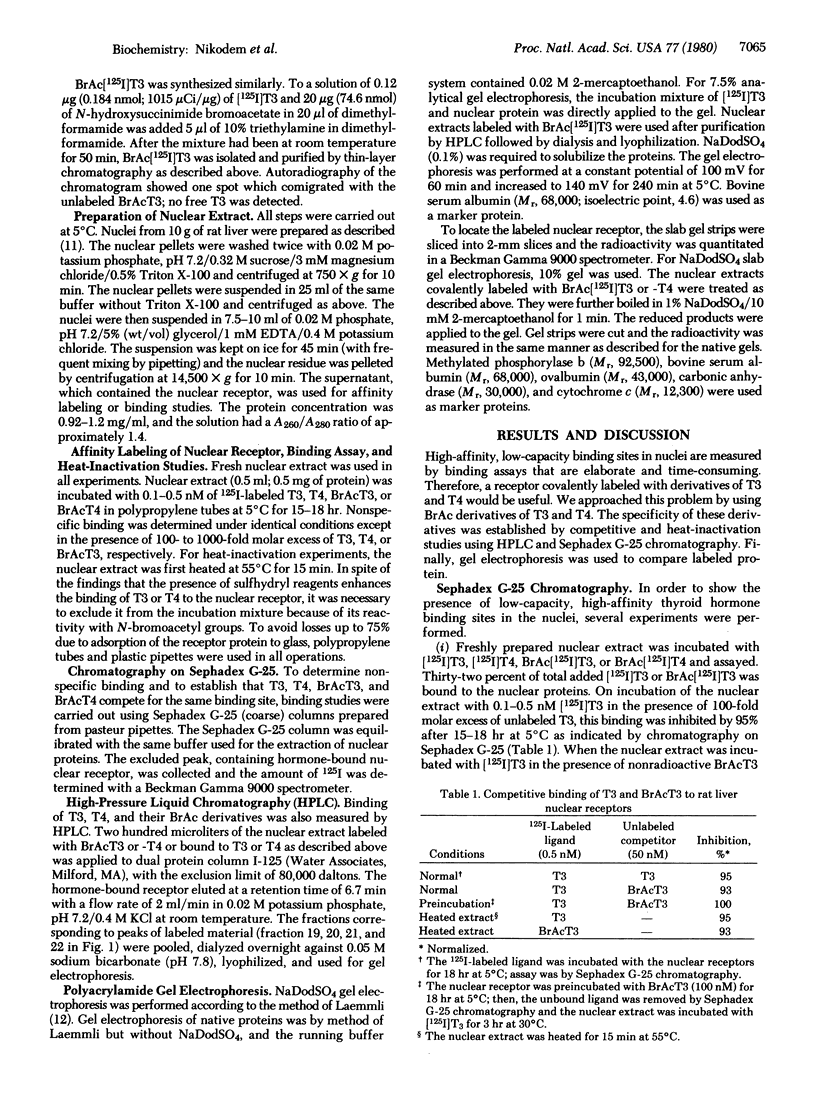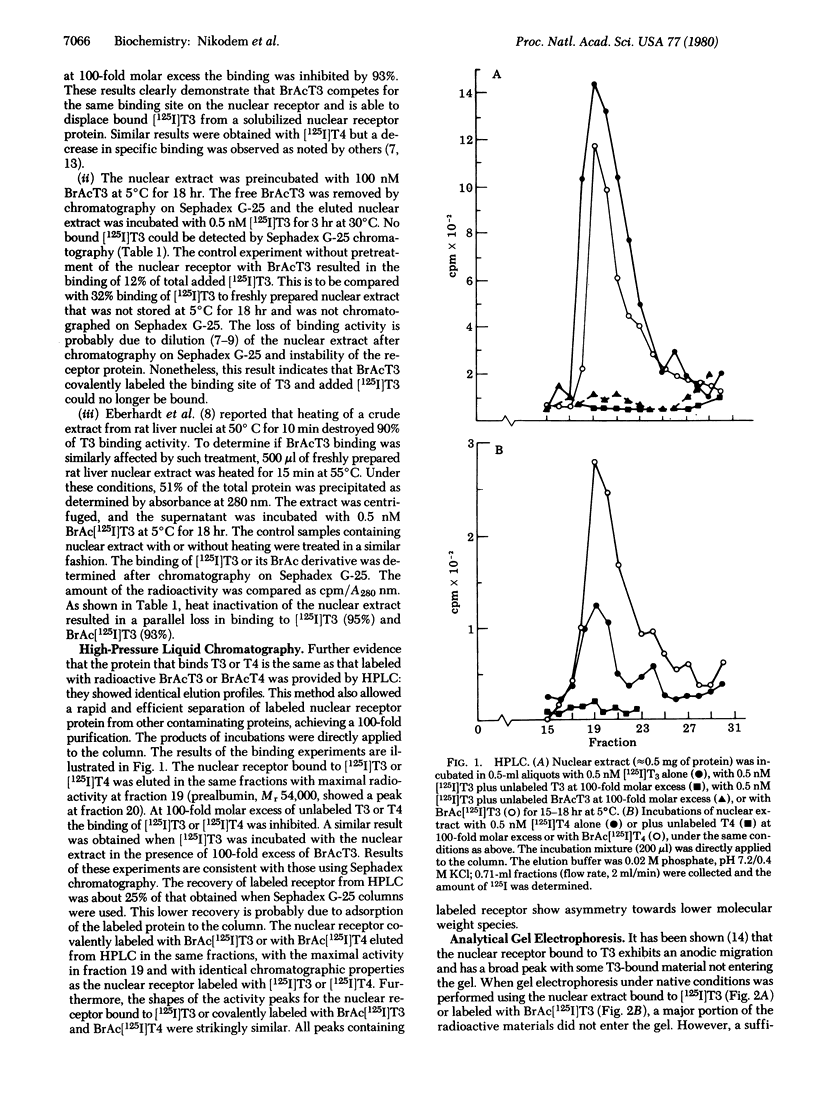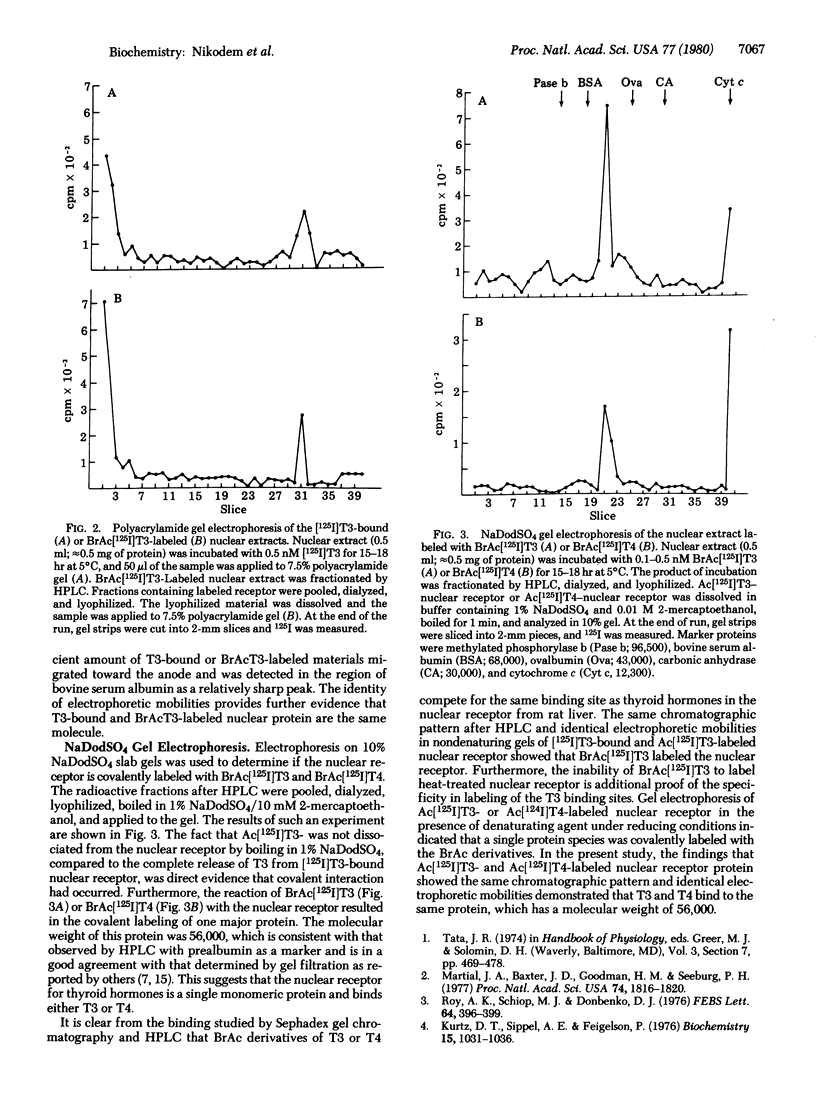Abstract
The thyroid hormone receptor from rat liver nuclei has been covalently labeled with the N-bromoacetyl derivatives of L-thyroxine (T4) and 3,3',5-triiodo-L-thyronine (T3). Displacement binding studies showed that, in the presence of 100-fold molar excess of unlabeled N-bromoacetyl-T3 or T4, binding of [125I]T3 or [125I]T4 was nearly totally inhibited. Heat inactivation of the receptor (55 degrees C for 15 min) resulted in parallel losses in the binding of T3 (95%) and N-bromoacetyl-T3 (93%). These results indicated that T3 and T4 and their bromoacetyl derivatives compete for the same binding site. The nuclear receptor showed identical behavior in high-pressure liquid chromatography (HPLC) whether bound to T3 or T4 or covalently labeled with their bromoacetyl derivatives. HPLC provided a single-step 100-fold purification of the nuclear receptor. Na-DodSO4 gel electrophoresis of the nuclear receptor labeled with N-bromoacetyl derivatives of [125I]T3 or [125I]T4 showed one major radioactive component with a molecular weight of 56,000. Furthermore, in the absence of denaturant, the nuclear receptor either bound to [125I]T3 or covalently labeled with N-bromoacetyl-[125I]T3 showed identical mobility. These results suggested that the nuclear receptor is a single polypeptide chain and binds either T3 or T4. Nuclear receptors covalently linked with N-bromoacetyl derivatives of [125I]T3 or [125I]T4 may be useful as a marker for the preparative purification of receptor.
Full text
PDF




Selected References
These references are in PubMed. This may not be the complete list of references from this article.
- Cheng S. Y. Labeling of serum prealbumin with N-bromoacetyl-L-thyroxine. Methods Enzymol. 1977;46:435–441. doi: 10.1016/s0076-6879(77)46052-x. [DOI] [PubMed] [Google Scholar]
- Degroot L. J., Refetoff S., Strausser J., Barsano C. Nuclear triiodothyronine-binding protein: partial characterization and binding to chromatin. Proc Natl Acad Sci U S A. 1974 Oct;71(10):4042–4046. doi: 10.1073/pnas.71.10.4042. [DOI] [PMC free article] [PubMed] [Google Scholar]
- Eberhardt N. L., Ring J. C., Johnson L. K., Latham K. R., Apriletti J. W., Kitsis R. N., Baxter J. D. Regulation of activity of chromatin receptors for thyroid hormone: possible involvement of histone-like proteins. Proc Natl Acad Sci U S A. 1979 Oct;76(10):5005–5009. doi: 10.1073/pnas.76.10.5005. [DOI] [PMC free article] [PubMed] [Google Scholar]
- Eberhardt N. L., Ring J. C., Latham K. R., Baxter J. D. Thyroid hormone receptors. Alteration of hormone-binding specificity. J Biol Chem. 1979 Sep 10;254(17):8534–8539. [PubMed] [Google Scholar]
- Kurtz D. T., Sippel A. E., Feigelson P. Effect of thyroid hormones on the level of the hepatic mRNA for alpha2u globulin. Biochemistry. 1976 Mar 9;15(5):1031–1036. doi: 10.1021/bi00650a013. [DOI] [PubMed] [Google Scholar]
- Laemmli U. K. Cleavage of structural proteins during the assembly of the head of bacteriophage T4. Nature. 1970 Aug 15;227(5259):680–685. doi: 10.1038/227680a0. [DOI] [PubMed] [Google Scholar]
- Latham K. R., Ring J. C., Baxter J. D. Solubilized nuclear "receptors" for thyroid hormones. Physical characteristics and binding properties, evidence for multiple forms. J Biol Chem. 1976 Dec 10;251(23):7388–7397. [PubMed] [Google Scholar]
- Martial J. A., Baxter J. D., Goodman H. M., Seeburg P. H. Regulation of growth hormone messenger RNA by thyroid and glucocorticoid hormones. Proc Natl Acad Sci U S A. 1977 May;74(5):1816–1820. doi: 10.1073/pnas.74.5.1816. [DOI] [PMC free article] [PubMed] [Google Scholar]
- Oppenheimer J. H., Schwartz H. L., Surks M. I. Tissue differences in the concentration of triiodothyronine nuclear binding sites in the rat: liver, kidney, pituitary, heart, brain, spleen, and testis. Endocrinology. 1974 Sep;95(3):897–903. doi: 10.1210/endo-95-3-897. [DOI] [PubMed] [Google Scholar]
- Oppenheimer J. H. Thyroid hormone action at the cellular level. Science. 1979 Mar 9;203(4384):971–979. doi: 10.1126/science.218285. [DOI] [PubMed] [Google Scholar]
- Roy A. K., Schiop M. J., Dowbenko D. J. The role of thyroxine in the regulation of translatable messenger RNA for alpha2u globulin in rat liver. FEBS Lett. 1976 May 1;64(2):396–399. doi: 10.1016/0014-5793(76)80335-3. [DOI] [PubMed] [Google Scholar]
- Surks M. I., Koerner D., Dillman W., Oppenheimer J. H. Limited capacity binding sites for L-triiodothyronine in rat liver nuclei. Localization to the chromatin and partial characterization of the L-triiodothyronine-chromatin complex. J Biol Chem. 1973 Oct 25;248(20):7066–7072. [PubMed] [Google Scholar]
- Surks M. I., Oppenheimer J. H. Concentration of L-thyroxine and L-triiodothyronine specifically bound to nuclear receptors in rat liver and kidney. Quantitative evidence favoring a major role of T3 in thyroid hormone action. J Clin Invest. 1977 Sep;60(3):555–562. doi: 10.1172/JCI108807. [DOI] [PMC free article] [PubMed] [Google Scholar]
- Torresani J., DeGroot L. J. Triiodothyronine binding to liver nuclear solubilized proteins in vitro. Endocrinology. 1975 May;96(5):1201–1209. doi: 10.1210/endo-96-5-1201. [DOI] [PubMed] [Google Scholar]


